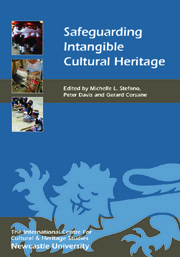Book contents
- Frontmatter
- Contents
- List of Illustrations
- Acknowledgments
- Touching the Intangible: An Introduction
- NEGOTIATING AND VALUING THE INTANGIBLE
- 1 The Paradoxes of Intangible Heritage
- 2 Memory, Museums and the Making of Meaning: A Caribbean Perspective
- 3 From Intangible Expression to Digital Cultural Heritage
- 4 Conversation Piece: Intangible Cultural Heritage in Sweden
- 5 Africa's Rich Intangible Heritage: Managing a Continent's Diverse Resources
- 6 The Silence of Meanings in Conventional Approaches to Cultural Heritage in Jordan: The Exclusion of Contexts and the Marginalisation of the Intangible
- 7 Conversation Piece: Intangible Cultural Heritage in India
- APPLYING THE INTANGIBLE CULTURAL HERITAGE CONCEPT
- ON THE GROUND: SAFEGUARDING THE INTANGIBLE
- List of Contributors
- Index
7 - Conversation Piece: Intangible Cultural Heritage in India
from NEGOTIATING AND VALUING THE INTANGIBLE
Published online by Cambridge University Press: 05 February 2013
- Frontmatter
- Contents
- List of Illustrations
- Acknowledgments
- Touching the Intangible: An Introduction
- NEGOTIATING AND VALUING THE INTANGIBLE
- 1 The Paradoxes of Intangible Heritage
- 2 Memory, Museums and the Making of Meaning: A Caribbean Perspective
- 3 From Intangible Expression to Digital Cultural Heritage
- 4 Conversation Piece: Intangible Cultural Heritage in Sweden
- 5 Africa's Rich Intangible Heritage: Managing a Continent's Diverse Resources
- 6 The Silence of Meanings in Conventional Approaches to Cultural Heritage in Jordan: The Exclusion of Contexts and the Marginalisation of the Intangible
- 7 Conversation Piece: Intangible Cultural Heritage in India
- APPLYING THE INTANGIBLE CULTURAL HERITAGE CONCEPT
- ON THE GROUND: SAFEGUARDING THE INTANGIBLE
- List of Contributors
- Index
Summary
Can you say something about the diverse nature of India and its peoples in relation to ICH?
India's rainbow peoples represent great diversity and their ICH appears interrelated and interdependent. Archaeological and historical evidence has provided us with an understanding of the successive periods of Indian history, which in turn facilitates reconstructions of our cultural history. However, recent research has focused on the cultural study of distinct communities and has yielded valuable insights into the contemporaneous aspects of tangible and intangible cultural heritages.
Contemporary intangible cultural traditions have distinct observable forms and it is possible to consider them objectively as expressions of human behaviour. In India references are made to intangible cultural traditions in prestigious publications, but also in newspapers, which in my opinion are reliable bearers of evidence concerning the current patterns of individual and collective human behaviour.
Is language a very significant form of ICH in India?
Language is an important vehicle of intangible cultural heritage all over India and is common to all communities irrespective of their religion. Sanskrit is the oldest language, but we are unsure where it originated, whether in India or elsewhere. Its relation with the people who lived in India during different periods is now a matter of intense debate. Efforts are currently being made to document and conserve tribal languages; the magazine Dhol (‘Drum’) has been very active in this regard. These languages – which have no written form since they are transmitted only orally, but embody the life and society of ancient civilizations – are fast disappearing owing to a lack of developmental support from the Indian Constitution.
- Type
- Chapter
- Information
- Safeguarding Intangible Cultural Heritage , pp. 85 - 92Publisher: Boydell & BrewerPrint publication year: 2012



